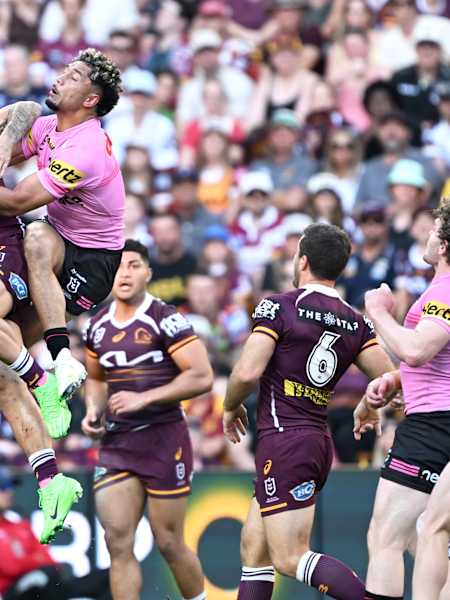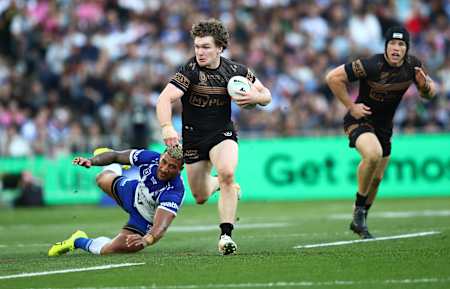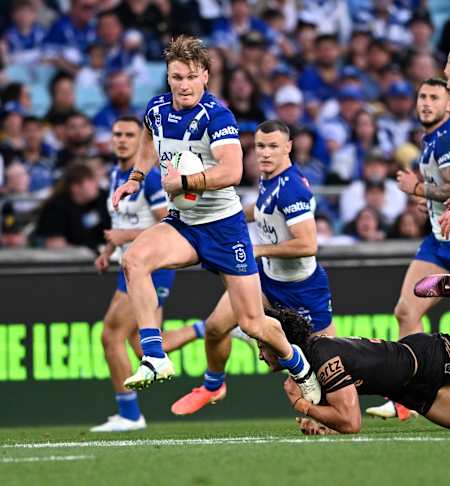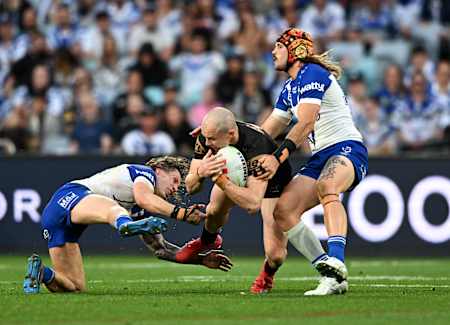Want to win a trip to Vegas for the opening NRL round? Be sure to submit your best Captains Call for a chance.
Rugby league is the greatest game of all. Well, at least that’s what they say in New South Wales and Queensland.
It’s built on tribalism with its showpiece event, State of Origin, considered Australian sport’s greatest rivalry. The three-game series between the Blues and Maroons often ranks as the highest-rating television program each year.
The passion for rugby league starts at a grassroots level though with 200,000 registering for community clubs last year to take the total participation number to approximately 1.03 million in 2024 – a 20% year-on-year increase.
There’s a pathway for both young boys and girls to pick up a footy at six-years old and play right through to one day become NRL and NRLW stars.
Rugby league originated in Australia back in 1908 as a breakaway competition from rugby union with the first grade competition being named the New South Wales Rugby League.
Eastern Suburbs and South Sydney were two of the foundation clubs and still exist today – but are better known as the Roosters and Rabbitohs.
The NRL is made up of 17 clubs, with that number to grow to 18 in 2028 when an historic Papua New Guinea team joins the competition.
10 clubs are NSW-based, four are Queensland-based, and there’s a team from New Zealand, Victoria and Canberra too.
As for the rules of the game, teams have six tackles to score a try. A try is worth four points and a kick to convert it is worth two points. Teams can also earn points via a penalty goal (two points), a field goal (one point), or as of 2021 a two-point field goal – which has to be kicked from at least 40-metres out.
The defending team must be 10 metres back from the attacking team at the start of each tackle to be deemed on-side, while the ball must be passed at a slight angle backwards – if it travels forward there’ll be a changeover and the other team gets a chance to attack.
An NRL game is made up two 40-minute halves, while the women’s format – NRLW – is made up of two 35-minute halves.
Rugby league’s positions can be broken down into three categories: the spine, backs and forwards. A team has 17 players – 13 start and four on the bench – and a total of eight interchanges can be made throughout the game.
In the NRL, the spine refers to four key positions that control and steer the team — basically the brain and heartbeat of the side. The spine players are:
01
FULLBACK (No. 1)
Fullbacks usually boast blistering speed, fast footwork and supreme skill, making them arguably the most exciting player on the field to watch.
They’ll always have their fingerprints on a team’s attack, whether it be scoring tries or setting them up with a neat pass. They’re often considered a team’s ‘x-factor’ and can demand the money to match that title.
But aside from the pretty stuff, they also play an important role in defence. They may only make on average three tackles a game but the No.1 is expected to be the voice at the back and organise the defensive line.
02
FIVE-EIGHTH (No. 6)
The halves can make or break a team’s season and if the halfback is Batman, then the five-eighth is Robin.
Many of the NRL’s halves partnerships are made up of a halfback who steers the ship and a five-eighth that has attacking flair.
A five-eighth often has a dangerous running game, a pinpoint passing game or a boot that wouldn’t look out of place in the NFL - like Matt Burton’s!
03
HALFBACK (No. 7)
For all of the American Football fans out there, a halfback is the quarterback of the team. They call the shots and tend to have the most influence on the outcome of a game. For that reason they’re usually one of the highest-paid players on a club’s roster – and as a result come under the most scrutiny when things don’t go to plan.
Penrith Panthers halfback Nathan Cleary is said to be the second-highest paid player in the NRL and given he was instrumental in the club’s four-peat (2021-2025), fans say he’s worth every cent of his reported $1.3 million salary.
A halfback has a deep knowledge of the game and can make decisions under pressure. They also have to be strong communicators because they have the important role of calling plays.
Halfbacks usually take on the bulk of the in-play kicking duties and depending on a coach’s game plan they may stay planted on one side of the field or they may roam from side to side when attacking.
04
HOOKER (No.9)
Low to the ground and a defensive machine is the best way to describe a hooker. If a player is over six foot tall they can almost forget about playing hooker because bending down to cleanly scoop up the ball and passing it at a rapid speed is the bread and butter of a hooker’s game.
In fact, the three best hookers in the game currently are 5’8” or shorter!
Hooker is arguably the most physically taxing position given they’re right in the middle of the action in both attack and defence. Not only do they tackle the biggest guys on the field but they also pop up behind every play the ball and have to get a pinpoint pass away at the start of each tackle.
Because of a hooker’s exhausting output, teams usually carry two in their 17 – one starts and one is on the bench.
In the NRL, the backs are the faster, more agile players who handle most of the attacking plays and cover the wider areas of the field. They're usually the ones scoring the flashy tries. The backs include:
05
WING (No. 2 and 5)
From acrobatic put-downs to taking tough carries of the ball, a winger plays an important role at both the start and end of a set.
If the opposing team finishes their set with a long kick, it’s usually the winger that catches it deep in their own half and charges back with the ball.
It’s usually a winger that finishes each season as the competition’s top try-scorer. And the way modern-day wingers can score with a one-hand put-down while the rest of their body is in the air – and over the sideline – is seriously impressive!
06
CENTRE (No. 3 and 4)
Centres sit on the inside of wingers and often throw the last pass to set up their winger for a try in the corner.
They love a one-on-one battle with their opposing centre - both in attack and defence - which is why strength and speed are a must.
In the NRL, the forwards are the big, powerful players who do the hard yards — smashing through defenses, making tons of tackles, and setting the platform for the backs to do their thing. The forwards are:
07
PROP (No. 8 and 10)
The biggest and scariest guys on the field.
Props have a pretty simple role – run hard and tackle hard. But it’s imperative that they deliver on that because it’s their runs that lay the platform and get the team into good field position for the halves to then set up tries.
The tallest prop in the NRL is 21-year-old Ben Te Kura, who is 6’7”, while the heaviest prop is Wiremu Greig, who is 124kg.
08
SECOND ROW (No. 11 and 12)
Also a forward, but more agile than a prop.
Second-rowers make a lot of tackles, but also contribute heavily in attack whether it be with an offload or hitting a line at speed out wide to break through the defence.
If a second-rower plays the full 80 minutes, expect to see them near the top of the tackle count.
09
LOCK (No. 13)
Consider this a roaming forward that is a hybrid of a prop and second-rower. They’re big enough to play in the middle, but fit enough and skillful enough to also play on an edge.
There was a time when coaches went for size and basically used this position as another prop, but over the last 10 years or so the role of lock has evolved to so much more.
A lock now acts as an extra playmaker, who has the size of a forward but the skill of a half.
10
BENCH (No. 14-17)
Coaches will either load their bench up with four forwards or as the game has gotten faster over the years, it’s become a popular move to include a utility-style player.
This is the ‘Mr. Fix It’ of the team – someone who can cover multiple positions.
The most common utility is a hooker/half but we sometimes see coaches pick a back on the bench and inject them late in the game in a roaming role.
Understanding the positions in NRL is essential for appreciating the speed, strategy, and physicality that define the game. Each role, from the powerful forwards to the agile backs, plays a crucial part in a team's success on the field. By knowing the responsibilities and skills required for each position, players and fans alike can gain deeper insight into how games are won and lost.
Whether you're stepping onto the field, coaching, or simply watching from the stands, a solid grasp of NRL positions brings you closer to the heart of the sport — where teamwork, tactics, and toughness reign supreme!






